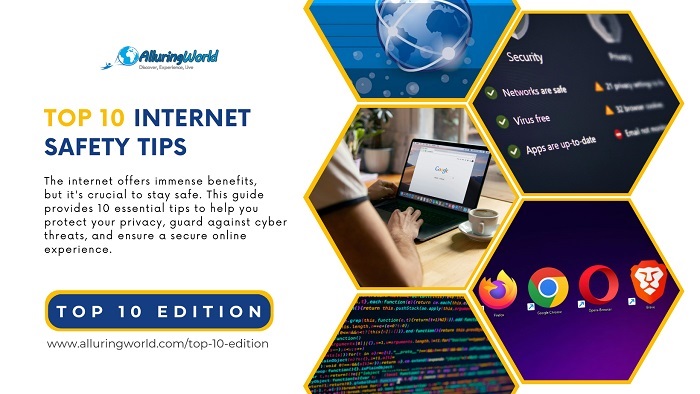The Internet really transformed our lives and made them completely different from what people were not able to imagine. Those changes made a big improvement in civilization and a huge development in almost every area of human life. However, among plenty of positive stuff that the internet brought to you, there are a couple of things that must be paid attention to and that can be negative. That is internet safety, which many people underestimate, and that can be very dangerous if it is not managed well. In this list, we will explain to you the basics of internet safety for everyday browsing and give you some ways to improve it.
1. Hiding your location from insecure sources
One of the things that can be threatened while browsing online is your location. Many websites seek location permission, and that information can be used for the wrong purposes, which can harm your safety. It can be easy for hackers to find out your real location by your IP address, and that can be a serious problem if it is not prevented. Showing your real location is unnecessary in many cases, and it must be provided just for websites that are 100% safe and that do not pose a threat to your privacy. It is great that for this problem, there is a very simple solution, and that is a VPN online, which is very simple to use. When a VPN is on, your location will be encrypted, and there is no way that any websites can get to you. This brings you additional benefits because you can use servers from all over the world and enter sources that were usually not available in your country.
2. Strong password and authentication settings
For every account that you have online, from social networks to banks, there must be a strong password and layers of authentication. Your bank account and all your private data online must be well protected, and with one simple password, you can risk a lot. Many people just set some simple passwords or PINs, which are not enough to protect their accounts. When you set multiple layers of authentication, then everything can be a lot more protected, and you will not need to worry that your data will be stolen.
3. Be more careful while using a public network
Public networks are not as safe as many people think, and online surfing on them can be really dangerous. The good thing is that public networks can give you free wi-fi when you need it, which can be very helpful in some situations. For those services, many providers want certain data of users, and that can disturb internet safety, and every user must be careful with the data they provide.
4. Update software regularly
Many internet threats are evolving and finding new ways to break the privacy of internet users. Software developers have their teams who always work on upgrading the system and finding ways to improve their security. That is why it is important to update your software regularly and ensure that browsing online is safer.
5. Be Wary of Phishing Attempts and Suspicious Links
Phishing scams are a common tactic used by cybercriminals to trick you into revealing personal information. Always be skeptical of unexpected emails, messages, or pop-ups asking for your login credentials, financial details, or other sensitive data. Before clicking on any link, hover over it to see the actual URL, and ensure it’s legitimate. If something looks suspicious, it’s best to err on the side of caution and avoid clicking altogether.
6. Understand and Manage Your Privacy Settings
Many online platforms, from social media to shopping sites, collect vast amounts of your personal data. Take the time to review and adjust your privacy settings on all your accounts. Limit the information you share publicly, control who can see your posts and photos, and opt out of data collection or sharing with third parties whenever possible. Being proactive about your privacy settings helps you control your digital footprint.
7. Use a Secure Browser and Browser Extensions Wisely
The web browser you use plays a significant role in your online security. Choose reputable browsers that prioritize user privacy and offer built-in security features. Additionally, while browser extensions can be helpful, they can also pose security risks if they’re malicious or poorly developed. Only install extensions from trusted sources, and regularly review the permissions they request to ensure they aren’t overreaching.
8. Regularly Back Up Your Important Data
Even with the best security measures, unforeseen events like malware attacks, hardware failures, or accidental deletions can lead to data loss. Regularly backing up your important files, documents, and photos to an external drive or a secure cloud service is crucial. This ensures that even if something goes wrong, you can recover your valuable information and minimize disruption.
9. Educate Yourself and Stay Informed About New Threats
The landscape of internet threats is constantly evolving. New viruses, scams, and hacking techniques emerge regularly. Staying informed about the latest cybersecurity news and best practices is vital. Follow reputable security blogs, news outlets, and expert advice to understand emerging risks and learn how to protect yourself effectively. Continuous learning is a key component of robust internet safety.
10. Enable Two-Factor Authentication (2FA) Wherever Possible
Beyond strong passwords, two-factor authentication (2FA) adds an extra layer of security to your accounts. When 2FA is enabled, even if someone guesses your password, they still need a second piece of information (like a code sent to your phone or generated by an authenticator app) to access your account. This significantly reduces the risk of unauthorized access and should be enabled on all sensitive accounts.
In conclusion, with the right ways and tools, internet safety can be at a much higher level, and a certain level of caution must be present. This list will help you to better understand the basics of internet safety and start browsing the internet more safely and securely.

